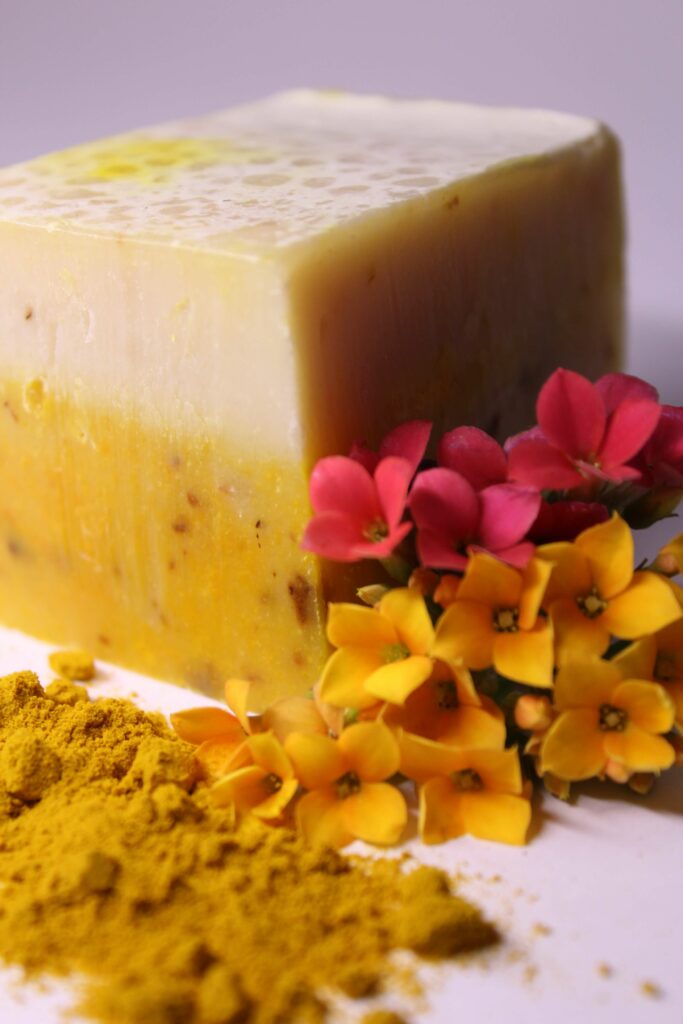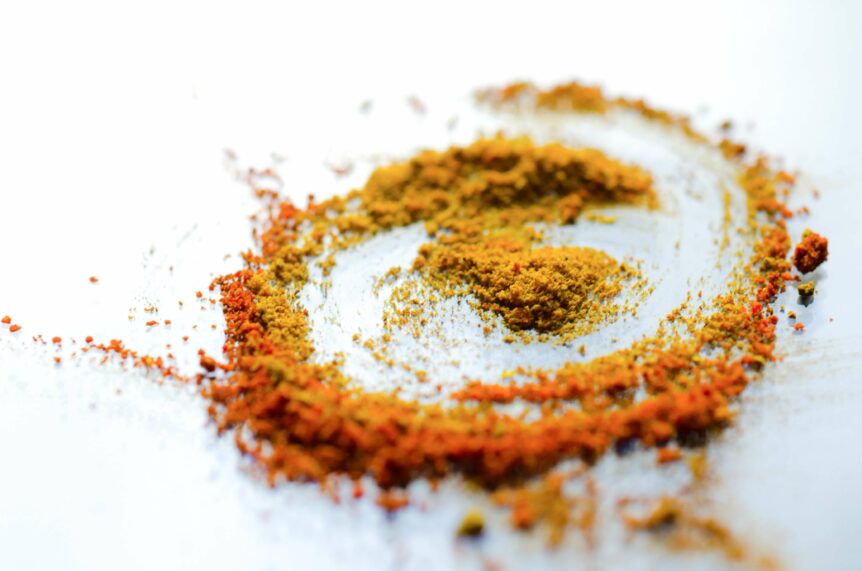Turmeric—It’s Not Just for Cooking Anymore. Think Skincare Benefits!
Check your spice rack. You may well find a container of turmeric, especially if you’re a fan of Indian-inspired curries, Middle Eastern pilafs, and other strongly flavored cuisines.
Surprisingly, turmeric has many uses beyond the kitchen, including as a skincare ingredient. The role of turmeric in skincare is the focus of this discussion, although this orange-golden-colored spice has been central to the centuries-old practice of Indian healing, traditional Chinese medicine, the Unani system of South Asia, and numerous other health approaches, touted as a cure for everything from arthritis to digestive disorders to liver and urinary ailments to wound healing. Turmeric is also used as a nutritional supplement, but consulting your doctor is highly recommended because regular ingestion may not be right for you.
Fortunately, experts do agree on the skincare benefits of turmeric in topical applications. In fact, research indicates that the skin-friendly substances contained in turmeric have been part of Ayurvedic tradition for 4,000 years.

The 4,000-Year History of Turmeric
Turmeric is a flowering plant in the ginger family. This perennial is native to the Indian subcontinent and Southeast Asia, requiring temperatures between 68 and 86 degrees Fahrenheit and high annual rainfall to grow to a mature height of 3 feet. After being boiled and dried, the rhizomes (creeping horizontal rootstalks) are ground into the powder used as a coloring dye, flavoring agent, food additive, and skin-nourishing substance. Turmeric’s most notable compound, which is unique in all nature to this plant, is curcumin. Rich in antioxidants, fatty acids, and vitamins, curcumin is responsible for skin treatments that have been practiced for thousands of years.
That the use of turmeric (pronounced TURR-murr-ick) goes back millennia is well documented by archeological finds in Indian temples and Israeli tombs dating between 2600 and 2200 BCE. Medical texts written in the 7th century BCE and found in the ruins of Nineveh (near present-day Mosul in northern Iraq) mention turmeric. Carried along trade routes throughout the known world, in medieval Europe turmeric was known as Indian saffron and used along with lavender, rosemary, and chamomile to formulate skincare masks for royalty and the highborn.
So you’re certainly in good company when you add turmeric to your skincare routine.

How Turmeric Benefits Your Skincare
Thanks to the bio-active component curcumin, turmeric is filled with anti-inflammatory, antimicrobial, and antioxidant properties that can improve skin health and appearance. Check out these benefits.
Improved skin tone and natural glow
Skincare products formulated with turmeric and curcumin help improve the appearance of skin irregularities like blotchiness, blemishes, dark spots, discolorations, dullness, redness, and unevenness. Because it adds brightness and luster, turmeric is often used at Indian weddings and other rituals to revitalize skin before a big event.
Protection against oxidative stress
Free radicals develop after exposure to an environmental stressor such as UV radiation, air pollution, radiation, or smoking build up on the skin and lead to visible changes. (Free radicals are complicated and not well understood; suffice it to say that these unstable molecules can damage cells, causing illness and aging, especially if left on the skin.) By helping neutralize free radicals, the antioxidants in turmeric limit damage.
Treatment of acne breakouts, atopic dermatitis, and psoriasis
With anti-inflammatory and antimicrobial ingredients, turmeric helps kill the bacteria that cause acne and psoriasis and may counteract some irritants that trigger atopic dermatitis. Turmeric application also reduces inflammation and dryness, leading to less scarring and allowing the skin to heal.
Reduction of dark circles
This common skin concern results from lack of sleep, unhealthy eating, hyperpigmentation from excess melanin, and spending too much time on computer and phone screens, among other causes. As a lightening agent, turmeric minimizes the appearance of dark circles by boosting circulation to reduce puffiness and lighten under-eye skin.
Moisturizing dry skin
Another frequent complaint has to do with dull, dried-out complexion, especially during winter. Turmeric-based products return moisture, in part by removing dead cells so new ones can regenerate, as well as adding fatty acids and vitamins to the skin.
Slowing down visible signs of aging
The curcumin found in turmeric helps lessen fine lines, age spots, and wrinkles by counteracting age-related dryness, strengthening elasticity, retaining moisture, and boosting collagen production. Natural oil balance is also restored.

OTC Products vs. DIY Treatments
When it comes to incorporating turmeric products into skincare, you have two choices: buy over-the-counter or make your own. Both methods are effective; the difference is how much work you want to put into your turmeric routine.
The advantage of OTC products is they are widely available and ready to use. Most major retailers carry a selection of turmeric-infused items, including creams, gels, masks, and oils, all designed to cleanse, firm, moisturize, soothe, tone, and otherwise improve the appearance of skin. Beauty supply specialists have even more choices. Be sure to study labels carefully so you know what you’re getting, what the product is designed to do, and how much turmeric and curcumin are contained.
Going do-it-yourself means having the necessary ingredients on hand and taking the time to mix them into the items you desire. First and foremost, you must have turmeric powder. Some large retailers have turmeric powder on the shelf; health food stores or Indian/Asian shops are other possible sources. Or order online. Depending on what you’re making, you’ll be combining the turmeric powder with other ingredients such as honey, olive oil, milk, yogurt, water, sandalwood or chickpea powder, or other natural ingredients, so have those ready to go. Recipes are readily available online.
Whether you choose the OTC or DIY approach, dermatologists and skincare specialists recommend using turmeric products in the morning on clean, dry skin. If you’re new to turmeric, be sure to perform a 48-hour patch test away from your face to check your skin’s tolerance. Allergic reactions can lead to swelling, redness, or irritation—just what you’re trying to avoid. And using turmeric two or three times a week is enough.
Side Effects, Cautions, and the Bottom Line
The most important downside to DIY turmeric is—it stains. The yellow-colored chemical in curcumin permanently dyes fabrics if not removed immediately through thorough washing and air drying. It also leaves a yellow residue if kept on the skin for more than 15 minutes or not rinsed off completely after use. To avoid the problem, buy Kasturi turmeric for DIY purposes, but remember that Kasturi turmeric is not edible, so do not use it in food.
When shopping OTC, you’ll see that prices are widely variable, with some products available at an accessible price point and other items in yikes territory. Since finding turmeric that works for you may be a trial-and-error process, take your time and consider carefully before you buy.
Also, remember that seeing results takes time. Generally, you’ll need at least four weeks to see signs of improvement in whatever condition you’re trying to treat.
On the other hand, turmeric clearly has important skin-enhancing properties that leave your skin brighter, tighter, lighter, and glowing. Four thousand years of testing prove that it works.

